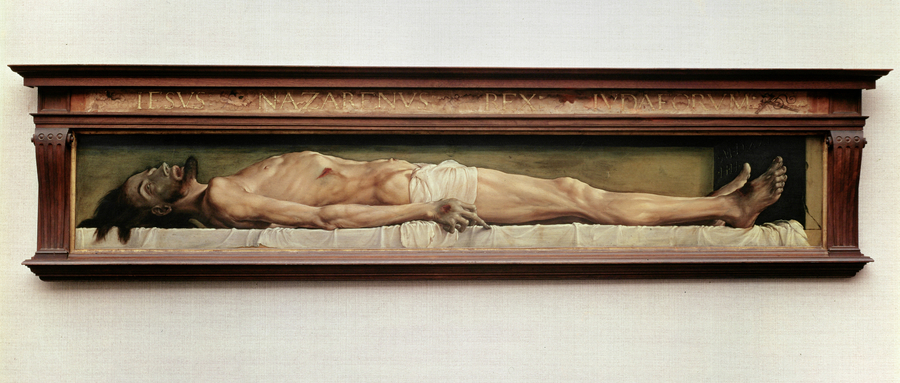“Why, some people may lose their faith looking at that picture!” Dostoyevsky famously had his fictional character Prince Myshkin exclaim over Hans Holbein the Younger’s Dead Christ Entombed.1 Almost five centuries after its creation, Holbein’s image is still shocking, difficult, even repulsive. We, the viewers, are boxed into a claustrophobic space with a cadaver, and not just any corpse, but the body that Christians assert has the potential to save humankind. Ribs jut out, every muscle, every tendon is revealed in the almost skeletal mass. Rancid green face, hands, feet, and wounds have already begun to succumb to putrefaction. We are even denied the comfortable fiction of sleep, as eyes continue their empty gaze upward. We see only the slightest shadow to remind us of the tomb’s lid, shut and heavy, the door that brooks no exit. If we accept the charge of looking at annihilation, at confronting the iconoclastic dismantling of convention before us, we must also admit that images like this one are hard on the eyes.
The racked torso. Holbein’s Christ lies broken before us, and his dissipated corpse reminds us of our own impending physical death as it also suspends the opportunity of salvific redemption. That most elastic of sign systems, the human body, could no longer stretch to cover the divine. The trope was exhausted. If the human person was molded as a wax figure after the image of Christ, the horror Holbein’s image elucidates is the statue melting before our very eyes.
A pierced hand putrefies, a meditation on essence and its legacy, the material censure of embodied memory. If the Eucharist was the model for every Christian religious image, Eucharistic presence was understood in terms of a covenant that vanquished the mortal remains left on sarcophagus or slab with eternal life. But if matter was disputed, how should we understand its memorial, the silence after Christ’s death? In the search for a vernacular of belief, the re-use of materials posed the potential rehabilitation of the human body with every layer of translucent paint. The history of oil and panel, flesh and bone, ensured a performance of forgetting even as their presence reminded of what had come before, the place-holders of implied distance, and what exactly triumphed in the symbiosis of substance.
A rotting head. The problem was not limited to the physicality of the object but rather to its perception. Discerning the divine could easily be mapped onto the pictorial relationship of illusion to reality, image of corpse to actual cadaver. Embedded within the play of “thinghood” was the problem of showing the unknowable as apprehensible, the infinite as tangible. Everything—ligament and limb—became a monitor of the liminal space between touch and thought, faith and logic, actual and imagined. What we see in Holbein’s Christ is the flawed conversion of the everyday, the compact of a new beginning every morning. With the still soft tufts of hair that hang over the edge, underscoring the illusion of an open side of the box, we find release from the claustrophobic sepulcher. Freedom and life are regained. In the very weakness of the links between effective and affective human being, the spiritual enterprise was reborn in equal parts physical and psychological.
Heart, hand, head, and let us not forget the unknown foot: the brave alter-ego of the devotional viewer, the eye-witness to destruction, the audience that makes the accusation real. Like martus, the Greek root we preserve in our word “martyr,” the witness to Holbein’s elegiac image visually engages in the destruction of the tortured human body for faith. With this gaze the iconoclastic assault is complete. The aesthetics of terror risked no less than the canon of daily custom, the habitus or way of proceeding.
For, if we understand all objects as but partial images, we can then engage the absence as Christians turn to Good Friday and the Entombment for inspiration. Looking in the matrix of lack, fragility, and mystery is the proposition that iconoclastic viewing tenders whenever art and religion intersect. Because perhaps most importantly, fertile absence reminds viewers not to discount quite so quickly the rhetoric of doubt that objects perform in the umbrage of pictorial illusion. In the words of the Cubist Georges Braque, another unapologetic deconstructionist-creator, “Art is meant to disturb, science reassures.”2
Notes
Keywords
Imprint
10.22332/con.obj.2014.25
1. Mia Mochizuki, "Hans Holbein the Younger, Dead Christ Entombed," Object Narrative, in Conversations: An Online Journal of the Center for the Study of Material and Visual Cultures of Religion (2014), doi:10.22332/con.obj.2014.25
Mochizuki, Mia. "Hans Holbein the Younger, Dead Christ Entombed." Object Narrative. In Conversations: An Online Journal of the Center for the Study of Material and Visual Cultures of Religion (2014). doi:10.22332/con.obj.2014.25



